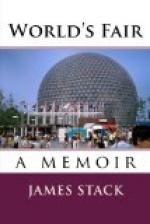The immensity of the building left scope for the rich volume of sound poured forth; and you may imagine what an effect the splendid strains had on the feelings of the multitude of spectators. Indeed, one of the audience,—a Chinaman, was so excited by the grandeur of the scene, and the triumphant music, that he rushed forwards, made his way through the crowd of nobles and ladies that surrounded the Queen, and, advancing close to Her Majesty, saluted her by a grand salaam, which she graciously acknowledged with a smile and a bow. A salaam, you must know, is the eastern way of bowing, and consists in bending the head until it almost touches the ground.
When the Hallelujah chorus ceased, the procession was formed for the Queen to go round the building. First went the heralds, in their splendid costumes; then a great number of gentlemen, who were more immediately concerned with the Exhibition; after them, the Duke of Wellington,—of whom, I dare say you know,—with more gentlemen, and the Archbishop of Canterbury; and then the Queen and Prince Albert, with the Prince of Wales, and the Princess Royal, both of whom looked extremely delighted and astonished with the gorgeous spectacle they were viewing. The Royal Family was followed by a number of lords, ladies, and attendants, the procession being concluded by heralds.
The train first went to the west end of the nave, on the north side, everybody cheering loudly as it passed. The view varied every minute, but was always picturesque, and beautiful. Even those persons who were most acquainted with the wondrous objects that lay on every side, were surprised by the new and charming attractions displayed. The Indian collection, and the compartment filled with specimens from the colonies, were left behind; the department devoted to sculpture, and other finer products of industry, was passed, and the procession moved into that portion of the palace which contains the English manufacturing products. You might then have caught a glimpse, over the heads of the spectators, of the Furniture Court, where the furniture is placed; and of the fixed machinery beyond it, the massive iron form of each machine looking as much as to say “move me, if you can.” Then the procession passed the enormous dome of iron and glass, the two gigantic statues, the figure of Shakspeare, and the many other objects which adorn the centre aisle; leaving behind the furs of bears, and other wild animals, hung beneath the galleries, and the carpets which lent their brilliant colours to finish the decorations; it reached the western entrance, where it was reflected in the immense mirror, exhibited at that point. Then, turning round by the model of the Liverpool Docks, it was returning on the south side of the nave, when the gigantic organ placed there, suddenly hurled forth an immense volume of music, which sounded extremely fine: but every one was already so much astonished, that I do not think anything more could surprise them.




